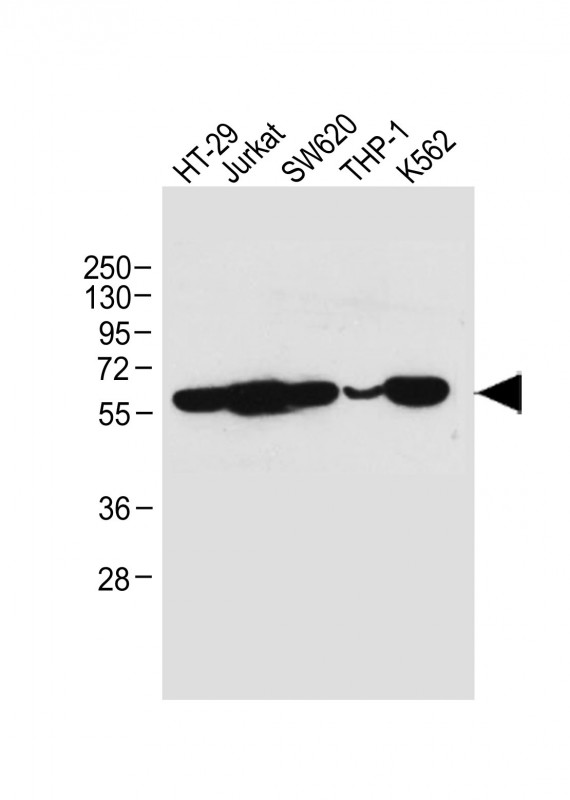
| WB | 咨询技术 | Human,Mouse,Rat |
| IF | 咨询技术 | Human,Mouse,Rat |
| IHC | 咨询技术 | Human,Mouse,Rat |
| ICC | 技术咨询 | Human,Mouse,Rat |
| FCM | 咨询技术 | Human,Mouse,Rat |
| Elisa | 咨询技术 | Human,Mouse,Rat |
| Aliases | Receptor-interacting serine/threonine-protein kinase 3, 2.7.11.1, RIP-like protein kinase 3, Receptor-interacting protein 3, RIP-3, RIPK3, RIP3 |
| Entrez GeneID | 11035 |
| WB Predicted band size | 56.9kDa |
| Host/Isotype | Mouse IgG1 |
| Antibody Type | Primary antibody |
| Storage | Store at 4°C short term. Aliquot and store at -20°C long term. Avoid freeze/thaw cycles. |
| Species Reactivity | Human |
| Immunogen | This RIPK3 antibody is generated from a mouse immunized with a recombinate protein from the human region of human RIPK3. |
+ +
以下是3篇与RIPK3抗体相关的文献概览:
1. **文献名称**: "RIPK3 deficiency or catalytically inactive RIPK1 provides greater benefit than MLKL deficiency in mouse models of inflammation and tissue injury"
**作者**: Newton K et al.
**摘要**: 研究通过RIPK3特异性抗体验证基因敲除小鼠模型中蛋白表达缺失,发现RIPK3缺失比MLKL缺失更能缓解炎症反应,提示RIPK3在坏死性凋亡通路中的核心作用。
2. **文献名称**: "A novel RIPK3 antibody for the detection of human and murine necroptosis"
**作者**: Takahashi N et al.
**摘要**: 开发了一种高特异性RIPK3抗体(克隆号D1W7T),适用于人鼠样本的免疫印迹和免疫组化,验证其在检测坏死小体形成和疾病模型(如胰腺炎)中的应用。
3. **文献名称**: "Antibody-mediated neutralization of RIPK3 ameliorates ischemic brain injury"
**作者**: Ofengeim D et al.
**摘要**: 利用RIPK3中和抗体抑制激酶活性,在小鼠脑缺血模型中显著减少神经元坏死性死亡,表明靶向RIPK3的治疗潜力。
4. **文献名称**: "Distinct roles of RIPK1 and RIPK3 in TNF-induced necroptosis"
**作者**: He S et al.
**摘要**: 通过RIPK3抗体结合基因沉默技术,证明RIPK3是TNF诱导坏死的关键调控因子,而RIPK1则具有促存活和促坏死的双重功能,依赖其磷酸化状态。
---
**注**:以上信息基于近年研究热点整理,实际文献可能存在更复杂机制。建议通过PubMed或Web of Science检索具体抗体货号(如CST #95702)获取实验细节。
**Background of RIPK3 Antibody**
Receptor-interacting protein kinase 3 (RIPK3) is a serine/threonine kinase belonging to the RIP kinase family, primarily recognized for its role in regulating necroptosis, a form of programmed necrotic cell death. Unlike apoptosis, necroptosis involves membrane rupture and inflammatory responses, mediated through RIPK3-dependent phosphorylation of mixed lineage kinase domain-like protein (MLKL). This pathway is typically activated under conditions where apoptosis is inhibited, such as during viral infections or inflammatory diseases, and is triggered by TNF receptor family members, Toll-like receptors (TLRs), or other cellular stressors.
RIPK3 antibodies are essential tools for detecting and quantifying RIPK3 expression and activation in research. Structurally, RIPK3 contains an N-terminal kinase domain and a C-terminal RIP homotypic interaction motif (RHIM), enabling interactions with other RHIM-containing proteins like RIPK1 or TRIF. Dysregulation of RIPK3 is implicated in pathologies including cancer, neurodegenerative disorders (e.g., Alzheimer’s), and autoimmune diseases, making it a therapeutic target.
Antibodies targeting RIPK3 are used in techniques such as Western blotting, immunohistochemistry, and flow cytometry to study its expression, post-translational modifications (e.g., phosphorylation at Thr231/Ser232), and interactions. Specificity varies, with some antibodies distinguishing between human and murine RIPK3 or detecting active versus inactive forms. Recent studies also highlight RIPK3's non-necroptotic roles in inflammation, metabolism, and pathogen defense, expanding the utility of RIPK3 antibodies in diverse research contexts.
×